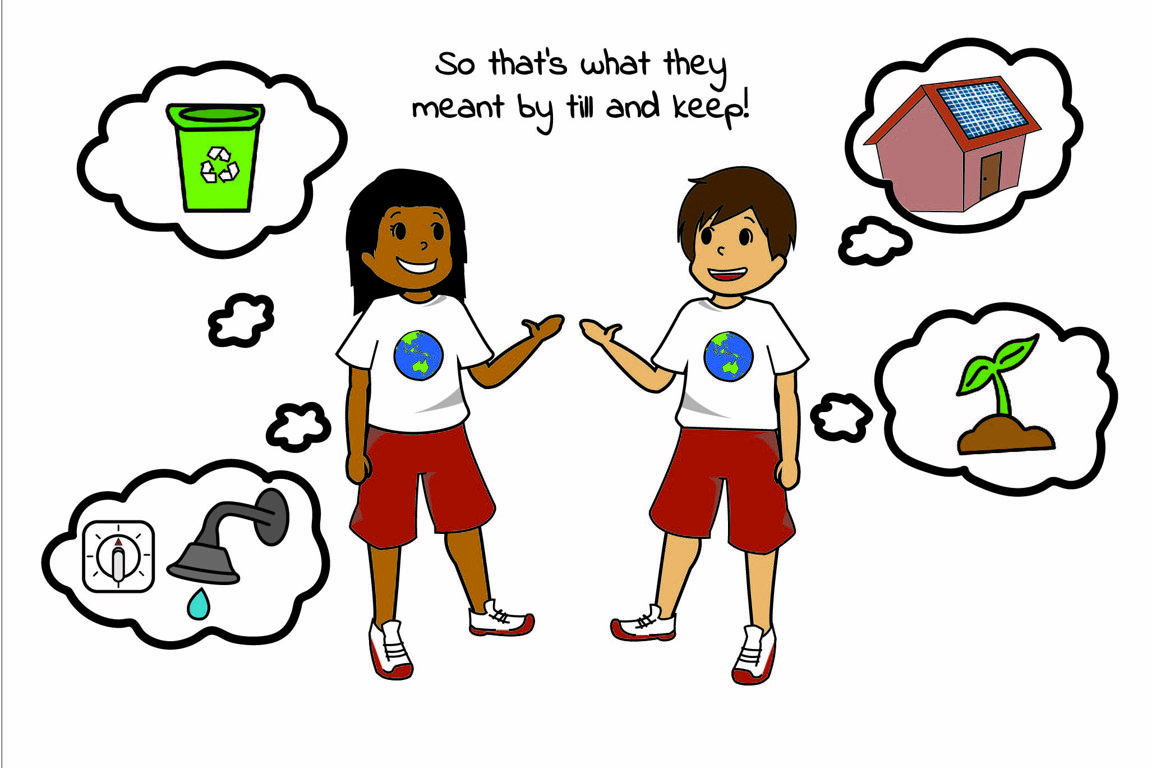Upper Primary
Care for our Common Home

How will I live Laudato Si’ and take Care of Our Common Home?
Teacher introduction
By the end of this unit, students will have understood the overarching themes outlined in Laudato Si’, who the document was written for and what it means for them to explicitly Care for Our Common Home. Using an area of personal interest students are required to investigate how they can take Care of Our Common Home and live out their response when listening to the cry of the earth and the cry of the poor.
This learning sequence has been created using the ‘See, Judge and Act’ model. This reflection–action process was first used by a Belgian Catholic priest, Joseph Cardijn (who later became a Cardinal) with Young Christian workers prior to the first World War. This approach was also recommended in the 1961 encyclical letter written by Pope John XXIII called Mater et Magistra (Mother and Teacher).
Teachers, before you start:
- Watch the Catholic Social Teaching Secondary film, ‘Care for Our Common Home’ , for your own background and familiarise yourself with the Care for Our Common Home Comic .
- Locate any Scriptures and copies of Church texts (all hyperlinked within the Learning Experience below).
- Familiarise and decide on the use of online or app technologies.
- Background information on Integral Ecology: Integral Ecology Framework and article by Dr Sandie Cornish: Integral ecology in the spirituality of Catholic Social Teaching
Curriculum Links
Learning Areas
- English
- Science
- Geography
- Technology
Cross-Curriculum Priorities
- Aboriginal and Torres Strait Islander Histories and Cultures
- Asia and Australia’s Engagement with Asia
- Sustainability
General Capabilities
- Ethical Understandings
- Personal and Social Capabilities

SEE
Students ‘See’ the issue related to caring for creation, know about Pope Francis’ encyclical Laudato Si, and understand what is meant by ‘Our Common Home’.
Pose the big question “How will you live Laudato Si’ and take Care of Our Common Home? to students.
Ask students what they will need to know in order to answer this question. (What is Laudato Si’? what is our Common Home and how do we care for it?)
Watch the Mocumentary called “The Majestic Plastic Bag” (4 mins). Before or after the film, discuss what a mocumentary is.
Think Puzzle Explore (teacher copy & student copy) to get students thinking about the issues that are presented in the film.
Ask students to:
- List the places the plastic bag went to on its migration to the Great Pacific Garbage Patch.
- Who or what lives in each of these spaces? Create a mind map. Add in the hidden species.
- Name some of the species affected by the plastic bag – they don’t need to be named in the mocumentary.
- Name some habitats that are missing in this journey. Name species missing in the documentary.
- Use the plastic bag as a way to trace the production of materials and the chain of who it affects.
Read ‘Welcome to Country’ by Aunty Joy Murphy and Lisa Kennedy (YouTube link if required)
- What perspective does this book offer that we have missed the point of in the film The Magestic Plastic Bag?
- What are the elders of this community asking?
- What other story in our church does this align with?
Watch and discuss Climate Change film (3 mins)
Watch the Laudato Si’ for Children film (4 mins)
- Use the Think Puzzle Explore thinking routine to get students to think about Laudato Si'
- Laudato Si’ Factsheet
Read or watch any or all of these case studies and answer the following questions.
Tati from Indonesia (Read / Watch 4 mins)
Thandolwayo from Zimbabwe (Read / Watch 6 mins)
Peter from the Solomon Islands (Read / Watch 2 mins)
Dinia from the Philippines (Watch 5 mins)
- What is/was happening?
- What is/was the environmental impact?
- Who is/was being affected?
- What is/has changing/changed?
- How is Caring for Our Common Home, demonstrated in this story.
Watch The Story of Stuff, Plastics You Throw Away, The Life Cycle of a T-Shirt
If time permits watch other videos on topics such as factory conditions, water quality etc. to give students an opportunity to go deeper. A Google search will provide these.
Who are the unseen people in all of these videos that the Story of Stuff talks about?
Reflect - Students complete a 3,2,1 Reflection – 3 things you learnt, 2 questions you have and one thing that you were challenged by.

JUDGE
Students begin unpacking the questions; What is the cry the earth and the cry of the poor and why are they inseparable? Why should I Care about Our Common Home? What happens if I don’t?
Display the Care for Our Common Home comic. This comic was inspired by the Canticle of Creation by Saint Francis of Assisi.
Optional – read the Canticle of Creation to the class and then revisit the comic.
Think Pair Share - What is the comic trying to tell us? How do we know?
Respond to the questions in each frame.
Moon – How can you care about me?
Sun – How can you care about me?
Water – How can you help care for me?
Trees – How can you help care for me?
Farmer – How can you help care for the land with me?
Extend – Identify another aspect of creation and consider how you can help care for it.
Discuss: How can an individual’s action or choices affect the local and global community?
Read Genesis 2:15
Define the key terms till and keep.
Discuss what Gospel values are being upheld when we care for creation or what Gospel values are denied when we don’t take care of the environment or each other?
Reflect - One of the many quotes in Laudato Si’ says:
“Today, however, we have to realize that a true ecological approach always becomes a social approach; it must integrate questions of justice in debates on the environment, so as to hear both the cry of the earth and the cry of the poor.” (Laudato Si’ n 49)
See the Laudato Si’ Factsheet for more quotes.
Make connections - Students review what they have learnt and answer the following questions.
- How are the case studies, Genesis 2:15 and the Laudato Si’ quote connected or what is common to them all?
- What is the ‘cry of the earth’?
- What is the ‘cry of the poor’?
- What is the link between the cry of the earth and the cry of the poor?
Fratelli Tutti – in 2020, Pope Francis released his third encyclical Fratelli Tutti. Pope Francis encourages us “to think of ourselves more and more as a single family dwelling in a common home.” (Fratelli Tutti n 17)
Think Pair Share – What do you think this quote from Fratelli Tutti means?
Reflect - Students complete a 3,2,1 Reflection – 3 things you learnt, 2 questions you have and one thing that you were challenged by.

ACT
Students will provide practical ways in which a particular interest of theirs can/does align with Laudato Si’ and how it contributes to Caring for Our Common Home or ways that it might contribute in the future, if it currently doesn’t.
Teacher note: If your school is a Catholic Earthcare School then invite student leaders to speak to your class about actions the school is already taking to care for creation. If your school is not a Catholic Earthcare school then learn more about the program and how to get involved here.
Investigate - Students investigate area they are passionate about – fashion, sport, travel etc
Respond - ‘How you can live Laudato Si’ and take Care of Our Common Home through… (chosen topic)?’
- Address the impact for the earth and for people.
- Use Question Starts to begin the investigation and think more deeply about the chosen topic.
- The Social Justice Planner found here may also be useful.
- Possible presentation modes: essay, PowerPoint, Poster, Flyer, newspaper article, persuasive speech or paper
For inspiration, see what others schools are doing to care for our common home through the Catholic Earthcare case studies.
Revisit the Care for Our Common Home comic. Using the Care for Our Common Home Comic - Student Activity – students fill in the thought bubbles with their answers to the original questions or a short prayer of thanksgiving.

PRAY
Watch Caring for our Earth: a prayer for children (4 mins).
Students write and illustrate their own prayer for creation to display around the classroom. Consider sharing these in your school newsletter and on your school website and social media channels to invite others to pray with you.
Also available is the Care for Our Common Home Prayer Service for Middle Primary.












